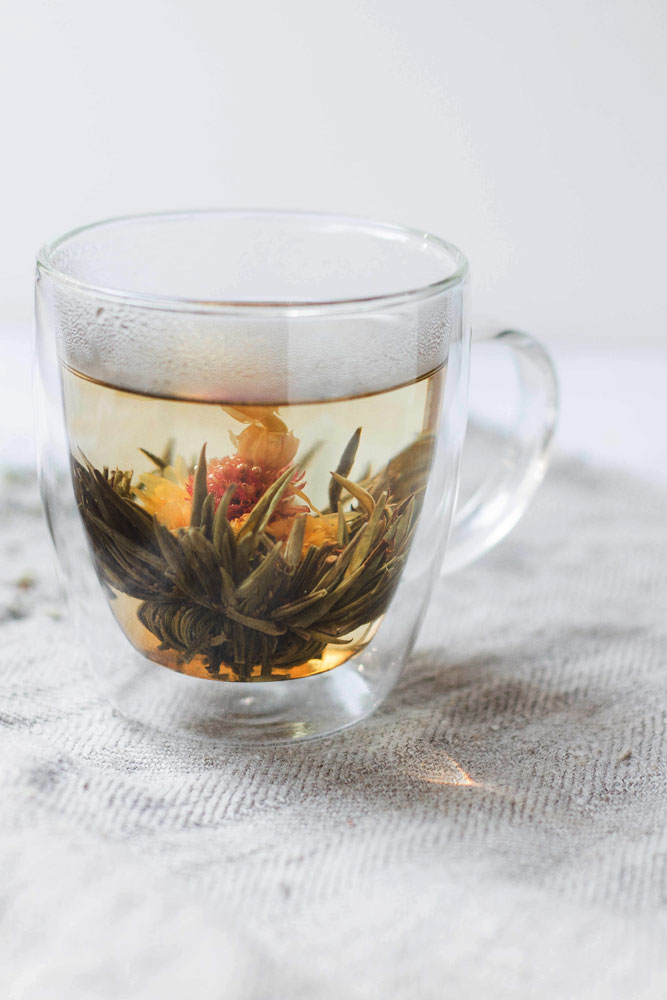In the western countries Chinese flowering tea is still a sort of a mystery. It is often placed in a separate category, and it is definitely the prettiest category as well. Flowering tea (often called blooming or artisan tea) originates from Chinese Yunnan Province, but today it is also produced in other provinces, such as Fujian and Anhui. Learn more about flowering tea benefits.
Uncertain History
Some believe this tea is fairly new, while others think it has been produced for more than 200 years. Some written sources say flowering tea has been around since the Song Dynasty, when tea leaves were bound with flowers to prepare a unique visual experience for the emperor. However, it is also said they were of a much poorer quality from what the emperor was used to, so he only enjoyed their beauty, without drinking them.
Thankfully, the beauty of Chinese blooming tea couldn't be neglected, so modern types are often made of exceptional leaves and flowers, offering much more than a visual experience. Flowering tea benefits are not to be neglected as well, as they offer combined properties of both tea leaves and flowers.
Flowering Tea Benefits Based on the Type of Flower
Most commonly used flowers for making flowering tea are jasmine, globe amaranth, chrysanthemum, peony, rose, violets and calendula (marigold). All of these flowers are more than often used in Chinese medicine and for making pure flower tea. Depending on flower, you can expect different health benefits. Therefore, flowering tea benefits cannot be placed into only one category and they will also depend on the type of tea leaves as well.
Calendula is often used for its soothing and anti-inflammatory properties, peony for alleviate stress, jasmine for treating wide range of liver problems, and chrysanthemum for cooling the body. Violets are not only very beautiful, they also have exceptional health benefits that include soothing cough and acting anti-inflammatory. Depending on the flower used, your tea will have different flavor as well. If they are combined with white tea leaves, flowering tea may have more anti-aging properties. On the other hand, black tea will offer a much higher levels of caffeine, making it perfect for afternoon tea break to increase energy levels.

About the tea leaves
Chinese Blooming tea is usually made from either green or white tea leaves. There are approximately 20-60 tea leaves used, wrapped using a thread with usually one to three flowers. Black tea is more rare in Chinese flowering tea, but we made an experiment with Organic Golden Monkey Paw black tea and created a unique Black Gold Blooming tea for those that prefer black teas and want to add a bit of beauty and additional health benefit to their tea drinking ritual.
To enjoy the flowering tea benefits you should always buy organic tea from the trustworthy source. Just as any other tea, the quality of flowering depends greatly on many different factors – from soil, to production processes and skillfulness of the producer.
Brewing Flowering tea
Flowering tea should always be brewed in a glass teapot or a glass cup. Another (more subjective) flowering tea benefit of each and every flowering tea is pure relaxation and bringing peace and beauty into your life. Watching the leaves unfurl is a relaxing experience. Flowering teas need a bit more time to brew and a bit higher temperature, so white tea such as silver needle and black teas are the best options. For green flowering teas we recommend a bit lower temperature and re-steep them until they fully unfurl. You can re-steep high quality black and white flowering teas at least two times.
You can see the full range of our flowering tea here.



Leave a Reply Cancel Reply